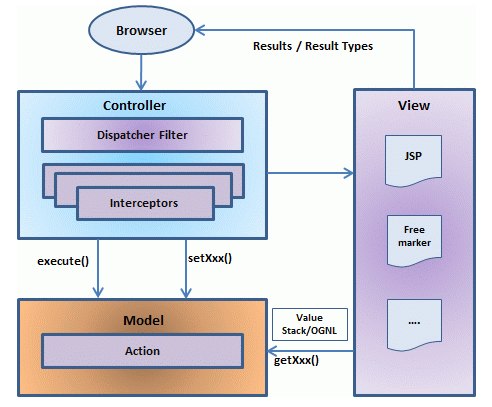Struts2的工作流程:
从一个高水平角度看,Struts2 是一个MVC拉动的(或MVC2)框架,Struts2 的模型-视图-控制器模式是通过以下五个核心部分进行实现的:
- 操作(Actions)
- 拦截器(Interceptors)
- 值栈(Value Stack)/OGNL
- 结果(Result)/结果类型
- 视图技术(jsp/freemark)
而Struts2 与传统的MVC框架略有不同,因为它由Action扮演模型的角色,而不是控制器,

浏览器发送请求,首先被配置在web.xml中的Dispatcher Filter过滤【Controller层】,然后根据用户请求的URL(也可以说是action name),到struts2的配置文件struts.xml文件中查找,该action name对应的action,并执行该action指定的方法【这一步骤对应上图中的Action,准备视图要展示的数据,称之为Model层】,方法执行完毕后会返回一个字符串(逻辑视图名),该字符串和配置在action中的result的name属性对应,跳转到真实的视图页面,到达页面后通过"值栈"/OGNL表达式从Model层中获取数据【View层】。
导入Struts2所需的jar包:
- commons-fileupload-x.y.z.jar
- commons-io-x.y.z.jar
- commons-lang-x.y.jar
- commons-logging-x.y.z.jar
- commons-logging-api-x.y.jar
- freemarker-x.y.z.jar
- javassist-x.y.z.GA
- ognl-x.y.z.jar
- struts2-core-x.y.z.jar
- xwork-core.x.y.z.jar
一:创建Action
HelloWorldAction.java
1 package cn.woo.action; 2 3 /** 4 * @Description:TODO HelloWorldAction 5 * @author: wyh 6 * @version: V1.0 7 * @Date: 2018年8月25日 上午11:16:20 8 */ 9 public class HelloWorldAction { 10 11 private String name; 12 13 public String getName() { 14 return name; 15 } 16 17 public void setName(String name) { 18 this.name = name; 19 } 20 21 public String execute() throws Exception{ 22 return "success"; 23 } 24 }
二:首页:index.jsp【入口页】
1 <%@ page language="java" contentType="text/html; charset=UTF-8" 2 pageEncoding="UTF-8"%> 3 <!-- 使用Struts2的标签库 --> 4 <%@ taglib uri="/struts-tags" prefix="s"%> 5 <!DOCTYPE html PUBLIC "-//W3C//DTD HTML 4.01 Transitional//EN" "http://www.w3.org/TR/html4/loose.dtd"> 6 <html> 7 <head> 8 <meta http-equiv="Content-Type" content="text/html; charset=UTF-8"> 9 <title>数据展示页</title> 10 </head> 11 <body> 12 欢迎:<s:property value="name"/> 13 </body> 14 </html>
三:欢迎页面【登陆成功后访问的页面】HelloWorld.jsp
1 <%@ page language="java" contentType="text/html; charset=UTF-8" 2 pageEncoding="UTF-8"%> 3 <!-- 使用Struts2的标签库 --> 4 <%@ taglib uri="/struts-tags" prefix="s"%> 5 <!DOCTYPE html PUBLIC "-//W3C//DTD HTML 4.01 Transitional//EN" "http://www.w3.org/TR/html4/loose.dtd"> 6 <html> 7 <head> 8 <meta http-equiv="Content-Type" content="text/html; charset=UTF-8"> 9 <title>数据展示页</title> 10 </head> 11 <body> 12 欢迎:<s:property value="name"/> 13 </body> 14 </html>
四:编写Struts2的配置文件 struts.xml【默认要放置在WEB-INF/classes文件夹下,该位置不固定,只要在web.xml文件中配置的时候指定就行。】
1 <?xml version="1.0" encoding="UTF-8"?> 2 <!DOCTYPE struts PUBLIC 3 "-//Apache Software Foundation//DTD Struts Configuration 2.0//EN" 4 "http://struts.apache.org/dtds/struts-2.0.dtd"> 5 <struts> 6 <!-- 设置struts.devMode为true表示,表明当前处于开发模式可以输出日志信息 --> 7 <constant name="struts.devMode" value="true" /> 8 <!-- 创建包,目的是划分一个区域,将多个Action区分开来,就像项目中的包【action多的时候,这是进行模块化的一种方式;还有一种方式就是将该配置文件查分成不同作用的多个文件,然后在每个struts配置文件的尾部引入后续的配置文件即可】 --> 9 <package name="helloworld" extends="struts-default"> 10 11 <!-- 定义索引操作,之前访问首页的时候直接使用的是index.jsp,现在访问的时候可以使用index.action的方式进行访问 --> 12 <action name="index"> 13 <result>/index.jsp</result> 14 </action> 15 16 <!-- 访问的时候使用的URL就是hello,访问hello的时候,会被Struts的过滤器和拦截器进行拦截,找到action name对应的action类 17 如: cn.woo.action.HelloWorldAction,然后会执行method对应的方法,执行完毕后返回的String[也就是逻辑视图名],会和下方 18 (<result>)中的name对应,然后跳转到真正的视图:HelloWorld.jsp中--> 19 <action name="hello" 20 class="cn.woo.action.HelloWorldAction" 21 method="execute"> 22 <result name="success">/HelloWorld.jsp</result> 23 </action> 24 </package> 25 </struts>
五:配置web.xml文件
1 <?xml version="1.0" encoding="UTF-8"?> 2 <web-app xmlns:xsi="http://www.w3.org/2001/XMLSchema-instance" xmlns="http://java.sun.com/xml/ns/javaee" xsi:schemaLocation="http://java.sun.com/xml/ns/javaee http://java.sun.com/xml/ns/javaee/web-app_3_0.xsd" id="WebApp_ID" version="3.0"> 3 <display-name>Struts2Demo</display-name> 4 <welcome-file-list> 5 <welcome-file>index.html</welcome-file> 6 <welcome-file>index.htm</welcome-file> 7 <welcome-file>index.jsp</welcome-file> 8 <welcome-file>default.html</welcome-file> 9 <welcome-file>default.htm</welcome-file> 10 <welcome-file>default.jsp</welcome-file> 11 </welcome-file-list> 12 13 <!-- 配置Struts的入口:FilterDispatcher过滤器 --> 14 <filter> 15 <filter-name>struts2</filter-name> 16 <filter-class>org.apache.struts2.dispatcher.FilterDispatcher</filter-class> 17 </filter> 18 19 <filter-mapping> 20 <filter-name>struts2</filter-name> 21 <!-- 配置过滤所有满足/*的请求 --> 22 <url-pattern>/*</url-pattern> 23 </filter-mapping> 24 </web-app>
六:配置日志输出路径logging.properties【默认放置在WEB-INF/classes文件夹中,如果文件夹不存在可自行配置】
1 org.apache.catalina.core.ContainerBase.[Catalina].level = INFO 2 org.apache.catalina.core.ContainerBase.[Catalina].handlers = 3 java.util.logging.ConsoleHandler